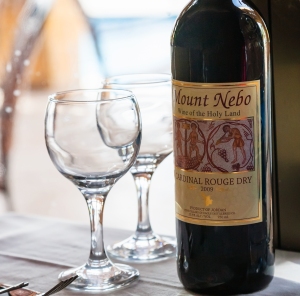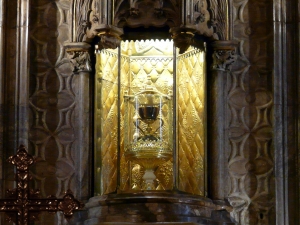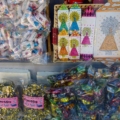In the Mediterranean world, wine is more than sustenance—it is a gesture of welcome, a shared memory, and a mark of hospitality woven into daily life and ritual. From the highlands of northern Jordan, where viticulture has endured since antiquity, to the cathedral vaults of Valencia, where the Holy Chalice is enshrined, the continuity of wine and vessel forms a tangible thread across centuries.
This is a story of how landscapes and objects preserve ritual memory—and how hospitality endures in material ways through time.
Jordan’s Ancient Vineyards
Though Jordan may not be commonly associated with wine today, its connection to viticulture is both ancient and well documented. Around Petra, the capital of the Nabataean kingdom, archaeologists have uncovered extensive networks of rock-cut wine presses dating to the first centuries BCE and CE. These installations indicate production on an industrial scale, likely integrated into wider trade networks throughout the Levant.

Further north, at Umm Qais—ancient Gadara—archaeological evidence of fermentation and storage facilities has also been found. Located along Roman roads, this region may have been one of several plausible sources of the wine used in ceremonial meals in Roman Judea. Some scholars have cautiously suggested that wine from this area could have been present at events such as the Last Supper, although no direct evidence confirms the link.
Regardless of such connections, the historical continuity of winemaking in Jordan is clear—and today, it is being revitalized with new energy.
The Soil Today: Jordan’s Wine Revival
In Mafraq, north of Amman, two wineries—Zumot and Haddad—have revived this ancient tradition with a blend of technical expertise and ecological sensitivity. The region’s basaltic soils, shaped by ancient volcanic activity, offer excellent drainage and mineral richness. High altitudes and cool nights extend the growing season, producing grapes of notable complexity and resilience.
Zumot’s Saint George wines and Haddad’s Jordan River label have earned international acclaim in blind tastings across Europe and Asia. These are not novelty exports, but authentic expressions of terroir—bottled landscapes that invite a deeper connection with Jordan’s living heritage.
Wine in Ritual History
The presence of wine in ritual meals spans the ancient Mediterranean. In Greco-Roman, Hebrew, and Nabataean cultures, wine symbolized community, celebration, and covenant.
The Last Supper, traditionally located in Jerusalem, is often interpreted through the lens of these shared cultural traditions. While theological interpretations vary, the act itself—a table set with bread and wine—mirrors the hospitality customs of the time. In such contexts, wine was not rare or inherently sacred, but a familiar part of communal life.
Moreover, within Jewish tradition, the wine cup used during the Passover meal (Pesach) holds deep ritual meaning. Four cups are consumed during the Seder, each representing a divine promise of redemption made to the people of Israel in the Book of Exodus. Thus, the cup shared by Jesus and his disciples can be seen as a moment imbued with symbolic weight—rooted in hope, liberation, and covenant.
Whether or not Jordan’s ancient wine regions were directly connected to such events, they remind us that the landscapes of these rituals once extended across territories that are now once again fertile with vines.

The Chalice of the Last Supper in Valencia
Thousands of kilometers to the west, in the city of Valencia, a stone cup known as the Holy Chalice is kept behind glass in the chapel that bears its name, within the Cathedral of Saint Mary. Revered since the medieval period as the vessel used at the Last Supper, its journey through history is complex and shrouded in tradition.
The cup itself, carved from polished chalcedony, measures 7 cm in height and 9.5 cm in diameter, and is believed to date to the first century CE, likely originating from the Eastern Mediterranean. According to tradition, the chalice was taken to Rome, hidden during times of persecution, and eventually brought to Spain by Saint Lawrence in the third century CE. It resurfaced in Christian Iberia centuries later and has remained in Valencia since the 15th century.
Aragonese and Valencian traditions identify this relic with the Holy Grail. In 1960, archaeologist Antonio Beltrán confirmed the cup’s early dating, and in 2019, art historian Dr. Ana Mafé García, applying scientific methodology, classified the vessel as a Kos Kidush—a Jewish blessing cup from the Second Temple period, contemporary with Herod the Great. The base and handles, richly adorned in gold, were likely added during the Middle Ages, transforming a humble object into a liturgical one.
Though the exact historical path of the chalice remains speculative, it stands as a testament to the continuity of sacred objects—moving across time and space, adapting to new meanings, and persisting in ritual life.
Vessels as Thresholds
The parallels between Jordan’s vineyards and Valencia’s chalice are not found in doctrine, but in gesture. In Valencia, the cup is a vessel of memory. In Jordan, wine flows again from ancient soils. Both reflect the enduring Mediterranean ideal of hospitality—embodied through vessels that nourish both body and spirit.
The wine presses of Petra, the basalt vineyards of Mafraq, and the chalice of Valencia speak to the enduring power of containers—not as static relics, but as thresholds: between guest and host, land and table, memory and present experience.
In each shared glass or quiet moment before an ancient cup, we encounter the Mediterranean tradition of welcome—an offering that continues to pour forward across time.





